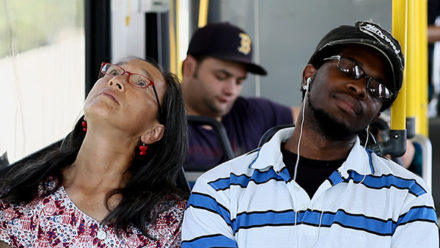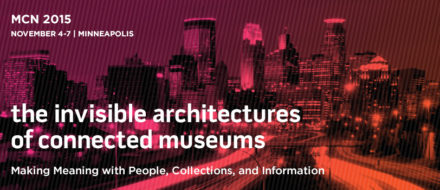
Throughout 2013, the Getty community participated in a rotation-curation experiment using the Getty Iris, Twitter, and Facebook. Each week a new staff member took the helm of our social media to chat with you directly and share a passion for a specific topic—from museum education to Renaissance art to web development. Getty Voices concluded in February 2014.
Each Monday we’ll have a new voice and a new topic, kicking off with a post on The Iris and continuing with more conversation throughout the week, led in weekly rotation by Getty staff.
As the voices change, so will the approaches. Sometimes we’ll take you behind the scenes with our work, other times we’ll mount a weeklong web exhibition, live-cover a symposium, or stage an online app festival. And the topics? Anything and everything relating to art, culture, and the Getty’s mission—seen from a creative angle. Every week we’ll include video and audio, and as we pick up speed we’ll build in online Q&As and Hangouts, too. Your input will help us guide the project as it evolves.
We’re looking forward to introducing you to these wonderful voices over the project’s first months:
- Claudia Cancino shares her Peru field notebook (see her post here)
- Annette Leddy takes us inside the mind of the forgotten surrealist
- Anne Woollett explores Vermeer
- Bryan Keene leads us on a journey through Renaissance gardens
- Murtha Baca, Anne Helmreich, and Susan Edwards tell us what’s happening in digital humanities
- The Villa Teen Apprentices dig into the ancient world & pop culture
To launch Getty Voices, we’ve redesigned The Iris as an online magazine with a clean, colorful look and a responsive design that’s easy to read on tablet and mobile. The magazine also features new, frequently updated content from outside the Getty, including videos and posts from other cultural institutions, journalists, and critics. (We’ll talk more about the decisions that went into redesign in a follow-up post.)
In planning Getty Voices we were deeply inspired by art experiments that are truly of the web, using technology as a creative medium to engage and inspire: the generosity of SmartHistory, the editorial intelligence of Walker Art Center, the radical inclusivity of SFMOMA’s Open Space, the personal warmth of the Met’s Connections (and now its beautifully immersive series 82nd & Fifth).
Being increasingly of the web, especially the social web, is one of our major goals at the Getty. Taking all our parts together (museum, conservation institute, grant-making foundation, research institute, art publisher, and store), we have over 15 social media spaces. So why more? Because Getty Voices sets out to do something more: to define a new voice for the Getty in the digital world, as a collective conversation between you and all of us—educators and gardeners, conservators and librarians, curators and security officers, scientists and designers. So much of what we do happens behind the scenes, and this new project aims to use the power of the web to make the whole Getty more accessible and more participatory than ever before.
Voices is a new way of working for us, a social media project that’s social from the inside out. It’s been exciting, challenging, revelatory, and full of unknowns. It’s a chance to take a risk and try something new, and we hope you’ll come and join us.




I am using your information in my classroom. Thank you for making it available. I love surrealism. I was excited to view the lost surrealist’s work.
Hi Elizabeth, Thanks so much for your kind comment. We’re delighted that you are using this information in your classroom, and I hope the students find it engaging. Annette Leddy, the curator who is telling us about the lost surrealist, tells me that the painting Space Unbound fascinates young visitors, and they very much enjoy looking at and sketching from it.
Would like to have it sent to my email
I would like to subscribe to the Iris online magazine. However, I do not have a Facebook or Twitter
account nor do I want one. Is there any other way to receive the magazine? Please let me know.
Jack Sanders
Hi Jack, Thanks for this comment. We had been considering adding a “subscribe by email” function to the Iris, and now we’ll definitely move ahead with it. We’ll send out a note in e-Getty when it’s ready. Thanks for your interest!
I’m a web developer and just wanted to say I LOVE this design – Its so fresh – and for once there was content that “lured” me in! WELL DONE you guys – I think you’ve adapted to today’s Social Media world and made it fly. Thank you
Hi Nadia—Thanks so much for the praise! We’re lucky to have a couple of total genius Web/WordPress developers, plus all our great experts on staff who’ve been eager to get involved by writing and participating in Voices. Thanks again!
Great idea. My question is simple: is there any way that I make get my voice heard through the iris?
Attached is a link to a Getty-relevant review published in the quarterly X-TRA.
http://x-traonline.org/?page_id=965
Sincerely —
Glenn Harcourt
Hi Glenn, Thanks so much for this comment and the link. I’ll add X-TRA to my radar for when I update the “Art News Around the Web” section on the homepage. In fact, I just added that very compelling interview with Anoka Faruqee.
As Getty Voices project moves forward, we’re very interesting in including many more of the community outside Getty staff, including artists, writers, critics, visitors, and more. I’ll be thinking through this in the spring; if you have suggestions or ideas (for either content or process), please share them! Thanks again.
I receive about 200 emails a day and admit to deleting the majority without perusing. However, this web offering intrigued and beguiled me. There is so very much content to be explored. No waste of time – for which I am grateful.